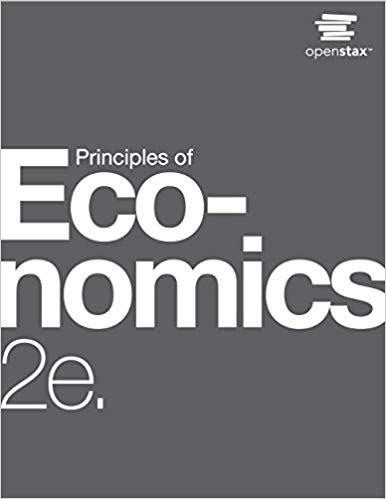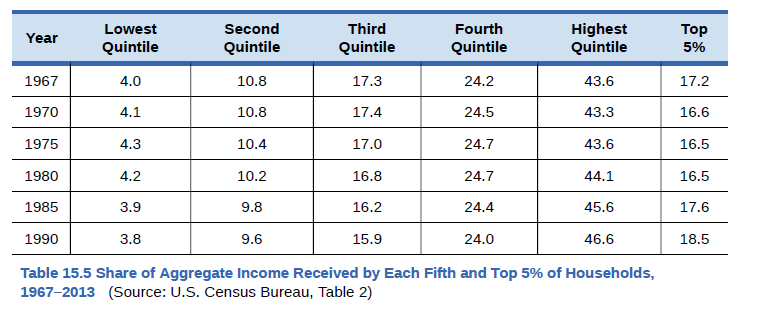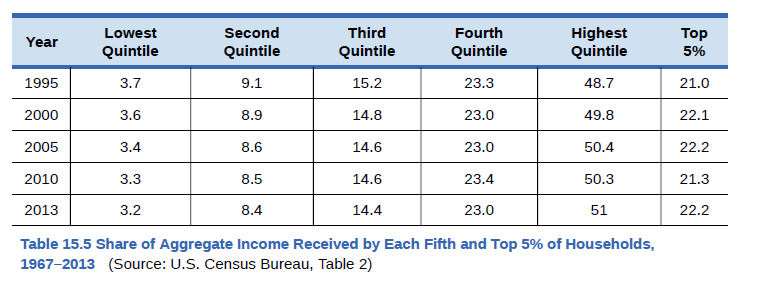
Principles of Economics 2e
2nd Edition
ISBN: 9781947172364
Author: Steven A. Greenlaw; David Shapiro
Publisher: OpenStax
expand_more
expand_more
format_list_bulleted
Textbook Question
Chapter 15, Problem 36CTQ
Explain how a country may experience greater equality in the distribution of income, yet still experience high rates of poverty. Hint: Look at the Clear It Up 'How do governments measure poverty in low-income countries?' and compare to Table 15.5.


Expert Solution & Answer
Want to see the full answer?
Check out a sample textbook solution
Students have asked these similar questions
Difference-in-Difference
In the beginning of 2001, North Dakota legalized fireworks. Suppose you are interested in
studying the effect of the legalizing of fireworks on the number of house fires in North
Dakota. Unlike North Dakota, South Dakota did not legalize fireworks and continued to ban
them. You decide to use a Difference-in-difference (DID) Model. The numbers of house fires
in each state at the end of 2000 and 2001 are as follows:
Number of house fires in Number of house fires in
Year
North Dakota
2000
2001
35
50
South Dakota
54
64
a. What is the change in the outcome for the treatment group between 2000 and 2001?
Show your working for full credit. (10 points)
b. Can we interpret the change in the outcome for the treatment group between 2000
and 2001 as the causal effect of legalizing fireworks on number of house fires?
Explain your answer. (10 points)
C.
Regression Discontinuity
Birth weight is used as a common sign for a newborn's health. In the United States, if a baby
has a birthweight below 1500 grams, the newborn is classified as having “very low birth
weight". Suppose you want to study the effect of having very low birth weight on the number
of hospital visits made before the baby's first birthday. You decide to use Regression
Discontinuity to answer this question. The graph below shows the RD model:
Number of hospital visits made before baby's first birthday
5
1400
1450
1500
1550
1600
Birthweight (in grams)
a. What is the running variable? (5 points)
b. What is the cutoff? (5 points)
T
What is the discontinuity in the graph and how do you interpret it? (10 points)
C.
Regression Discontinuity
Birth weight is used as a common sign for a newborn's health. In the United States, if a baby
has a birthweight below 1500 grams, the newborn is classified as having “very low birth
weight". Suppose you want to study the effect of having very low birth weight on the number
of hospital visits made before the baby's first birthday. You decide to use Regression
Discontinuity to answer this question. The graph below shows the RD model:
Number of hospital visits made before baby's first birthday
5
1400
1450
1500
1550
1600
Birthweight (in grams)
a. What is the running variable? (5 points)
b. What is the cutoff? (5 points)
T
What is the discontinuity in the graph and how do you interpret it? (10 points)
Chapter 15 Solutions
Principles of Economics 2e
Ch. 15 - Describe how each of these changes is likely to...Ch. 15 - Jonathan is a single father with one child. He can...Ch. 15 - Imagine that the government reworks the welfare...Ch. 15 - We have discovered that the welfare system...Ch. 15 - How does the TANF attempt to loosen the poverty...Ch. 15 - A group 0f 10 people have the following annual...Ch. 15 - Table 15.9 shows the share of income going to each...Ch. 15 - Using two demand and supply diagrams, one for the...Ch. 15 - Using two demand and supply diagrams, one for the...Ch. 15 - Here is one hypothesis: A well-funded social...
Ch. 15 - Here is a second hypothesis: A well-funded social...Ch. 15 - Which set of policies is more likely to cause a...Ch. 15 - Why is there reluctance on the part of some in the...Ch. 15 - How is the poverty rate calculated?Ch. 15 - What is the poverty line?Ch. 15 - What is the difference between poverty and income...Ch. 15 - How does the poverty trap discourage people from...Ch. 15 - How can the effect of the poverty trap be reduced?Ch. 15 - Who are the near-poor?Ch. 15 - What is the safety net?Ch. 15 - Briefly explain the differences between TANF, the...Ch. 15 - Who is included in the top income quintile?Ch. 15 - What is measured on the two axes of a Lorenz...Ch. 15 - If a country had perfect income equality what...Ch. 15 - How has the inequality of income changed in the...Ch. 15 - What are some reasons why a certain degree of...Ch. 15 - What are the main reasons economists give for the...Ch. 15 - Identify some public policies that can reduce the...Ch. 15 - Describe how a push for economic equality might...Ch. 15 - What goods and services would you include in an...Ch. 15 - If a family of three earned 20,000, would they be...Ch. 15 - Exercise 15.2 and Exercise 15.3 asked you to...Ch. 15 - Explain how you would create a government program...Ch. 15 - Many critics of government programs to help...Ch. 15 - Think about the business cycle: during a...Ch. 15 - Explain how a country may experience greater...Ch. 15 - The demand for skilled workers in the United...Ch. 15 - Explain a situation using the supply and demand...Ch. 15 - What do you think is more important to focus on...Ch. 15 - To reduce income inequality, should the marginal...Ch. 15 - Redistribution of income occurs through the...Ch. 15 - How does a society or a country make the decision...Ch. 15 - Explain what the long- and short-term consequences...Ch. 15 - In country A, the population is 300 million and 50...Ch. 15 - In country B, the population is 900 million and...Ch. 15 - Susan is a single mother with three children. She...Ch. 15 - A group of 10 people have the following annual...
Additional Business Textbook Solutions
Find more solutions based on key concepts
Create an Excel spreadsheet on your own that can make combination forecasts for Problem 18. Create a combinatio...
Operations Management: Processes and Supply Chains (12th Edition) (What's New in Operations Management)
(Record inventory transactions in the periodic system) Wexton Technologies began the year with inventory of 560...
Financial Accounting (12th Edition) (What's New in Accounting)
Determining Acquisition Cost. Haply, Inc. incurred the following expenditures when acquiring a new assembly mac...
Intermediate Accounting (2nd Edition)
Determine the FW of the following engineering project when the MARR is 15% per year. Is the project acceptable?...
Engineering Economy (17th Edition)
Discussion Questions 1. What characteristics of the product or manufacturing process would lead a company to us...
Managerial Accounting (5th Edition)
To what does the lifetime value of the customer refer, and how is it calculated?
MARKETING:REAL PEOPLE,REAL CHOICES
Knowledge Booster
Similar questions
- Experiments Research suggests that if students use laptops in class, it can have some effect on student achievement. While laptop usage can help students take lecture notes faster, some argue that the laptops may be a source of distraction for the students. Suppose you are interested in looking at the effect of using laptops in class on the students' final exam scores out of 100. You decide to conduct a randomized control trial where you randomly assign some students at UIC to use a laptop in class and other to not use a laptop in class. (Assume that the classes are in person and not online) a. Which people are a part of the treatment group and which people are a part of the control group? (10 points) b. What regression will you run? Define the variables where required. (10 points)arrow_forwardExperiments Research suggests that if students use laptops in class, it can have some effect on student achievement. While laptop usage can help students take lecture notes faster, some argue that the laptops may be a source of distraction for the students. Suppose you are interested in looking at the effect of using laptops in class on the students' final exam scores out of 100. You decide to conduct a randomized control trial where you randomly assign some students at UIC to use a laptop in class and other to not use a laptop in class. (Assume that the classes are in person and not online) a. Which people are a part of the treatment group and which people are a part of the control group? (10 points) b. What regression will you run? Define the variables where required. (10 points)arrow_forwardDummy variables News reports claim that in the last year television watching has increased. You believe that rising unemployment during Covid may be one of the causes for this. Suppose you are interested in looking at the effect of being unemployed on the hours spent watching Netflix per day. You collect data on 10,000 people from Chicago who are between the age of 20 and 60. You define the dummy variable Unemployed which takes the value 1 for those who are unemployed and 0 for those who are employed. Equation 1: Hours spent watching Netflix₁ = ßo + B₁Unemployed; + ε¿ Following is the output for equation 1: reg hours spent_watching_netflix unemployed Source SS df MS Number of obs 10,000 F(1, 9998) = 14314.03 Model Residual 3539.70065 2472.39364 9,998 1 3539.70065 .247288822 Prob F R-squared == 0.0000 = 0.5888 Total 6012.09429 9,999 . 601269556 Adj R-squared Root MSE = 0.5887 .49728 hours spen~x Coef. Std. Err. t P>|t| [95% Conf. Interval] unemployed cons 1.189908 .0099456 119.64…arrow_forward
- Dummy variables News reports claim that in the last year television watching has increased. You believe that rising unemployment during Covid may be one of the causes for this. Suppose you are interested in looking at the effect of being unemployed on the hours spent watching Netflix per day. You collect data on 10,000 people from Chicago who are between the age of 20 and 60. You define the dummy variable Unemployed which takes the value 1 for those who are unemployed and 0 for those who are employed. Equation 1: Hours spent watching Netflix₁ = ßo + B₁Unemployed; + ε¿ Following is the output for equation 1: reg hours spent_watching_netflix unemployed Source SS df MS Number of obs 10,000 F(1, 9998) = 14314.03 Model Residual 3539.70065 2472.39364 9,998 1 3539.70065 .247288822 Prob F R-squared == 0.0000 = 0.5888 Total 6012.09429 9,999 . 601269556 Adj R-squared Root MSE = 0.5887 .49728 hours spen~x Coef. Std. Err. t P>|t| [95% Conf. Interval] unemployed cons 1.189908 .0099456 119.64…arrow_forward17. The South African government's distributive stance is clear given its prioritisation of social spending, which includes grants and subsidised goods. Discuss the advantages and disadvantages of an in-kind subsidy versus a cash grant. Use a graphical illustration to support your arguments. [15] 18. Redistributive expenditure can take the form of direct cash transfers (grants) and/or in-kind subsidies. With references to the graphs below, discuss the merits of these two transfer types in the presence and absence of a positive externality. [14] 19. Expenditure on education and healthcare have, by far, the biggest redistributive effect in South Africa' by one estimate dropping the Gini-coefficient by 10 percentage points. Discuss the South African government's performance in health and education provision by evaluating both the outputs and outcomes in these areas of service delivery. [15] 20. Define the following concepts and provide an example in each case: tax rate structure, general…arrow_forwardSummarise the case for government intervention in the education marketarrow_forward
- Should Maureen question the family about the history of the home? Can Maureen access public records for proof of repairs?arrow_forward3. Distinguish between a direct democracy and a representative democracy. Use appropriate examples to support your answers. [4] 4. Explain the distinction between outputs and outcomes in social service delivery [2] 5. A R1000 tax payable by all adults could be viewed as both a proportional tax and a regressive tax. Do you agree? Explain. [4] 6. Briefly explain the displacement effect in Peacock and Wiseman's model of government expenditure growth and provide a relevant example of it in the South African context. [5] 7. Explain how unbalanced productivity growth may affect government expenditure and briefly comment on its relevance to South Africa. [5] 8. South Africa has recently proposed an increase in its value-added tax rate to 15%, sparking much controversy. Why is it argued that value-added tax is inequitable and what can be done to correct the inequity? [5] 9. Briefly explain the difference between access to education and the quality of education, and why we should care about the…arrow_forward20. Factors 01 pro B. the technological innovations available to companies. A. the laws that regulate manufacturers. C. the resources used to create output D. the waste left over after goods are produced. 21. Table 1.1 shows the tradeoff between different combinations of missile production and home construction, ceteris paribus. Complete the table by calculating the required opportunity costs for both missiles and houses. Then answer the indicated question(s). Combination Number of houses Opportunity cost of houses in Number of missiles terms of missiles J 0 4 K 10,000 3 L 17,000 2 1 M 21,000 0 N 23,000 Opportunity cost of missiles in terms of houses Tutorials-Principles of Economics m health carearrow_forward
- In a small open economy with a floating exchange rate, the supply of real money balances is fixed and a rise in government spending ______ Group of answer choices Raises the interest rate so that net exports must fall to maintain equilibrium in the goods market. Cannot change the interest rate so that net exports must fall to maintain equilibrium in the goods market. Cannot change the interest rate so income must rise to maintain equilibrium in the money market Raises the interest rate, so that income must rise to maintain equilibrium in the money market.arrow_forwardSuppose a country with a fixed exchange rate decides to implement a devaluation of its currency and commits to maintaining the new fixed parity. This implies (A) ______________ in the demand for its goods and a monetary (B) _______________. Group of answer choices (A) expansion ; (B) contraction (A) contraction ; (B) expansion (A) expansion ; (B) expansion (A) contraction ; (B) contractionarrow_forwardAssume a small open country under fixed exchanges rate and full capital mobility. Prices are fixed in the short run and equilibrium is given initially at point A. An exogenous increase in public spending shifts the IS curve to IS'. Which of the following statements is true? Group of answer choices A new equilibrium is reached at point B. The TR curve will shift down until it passes through point B. A new equilibrium is reached at point C. Point B can only be reached in the absence of capital mobility.arrow_forward
arrow_back_ios
SEE MORE QUESTIONS
arrow_forward_ios
Recommended textbooks for you

 Principles of MicroeconomicsEconomicsISBN:9781305156050Author:N. Gregory MankiwPublisher:Cengage Learning
Principles of MicroeconomicsEconomicsISBN:9781305156050Author:N. Gregory MankiwPublisher:Cengage Learning Principles of Economics (MindTap Course List)EconomicsISBN:9781305585126Author:N. Gregory MankiwPublisher:Cengage Learning
Principles of Economics (MindTap Course List)EconomicsISBN:9781305585126Author:N. Gregory MankiwPublisher:Cengage Learning Principles of Microeconomics (MindTap Course List)EconomicsISBN:9781305971493Author:N. Gregory MankiwPublisher:Cengage Learning
Principles of Microeconomics (MindTap Course List)EconomicsISBN:9781305971493Author:N. Gregory MankiwPublisher:Cengage Learning Principles of Economics, 7th Edition (MindTap Cou...EconomicsISBN:9781285165875Author:N. Gregory MankiwPublisher:Cengage Learning
Principles of Economics, 7th Edition (MindTap Cou...EconomicsISBN:9781285165875Author:N. Gregory MankiwPublisher:Cengage Learning Microeconomics: Principles & PolicyEconomicsISBN:9781337794992Author:William J. Baumol, Alan S. Blinder, John L. SolowPublisher:Cengage Learning
Microeconomics: Principles & PolicyEconomicsISBN:9781337794992Author:William J. Baumol, Alan S. Blinder, John L. SolowPublisher:Cengage Learning


Principles of Microeconomics
Economics
ISBN:9781305156050
Author:N. Gregory Mankiw
Publisher:Cengage Learning

Principles of Economics (MindTap Course List)
Economics
ISBN:9781305585126
Author:N. Gregory Mankiw
Publisher:Cengage Learning

Principles of Microeconomics (MindTap Course List)
Economics
ISBN:9781305971493
Author:N. Gregory Mankiw
Publisher:Cengage Learning

Principles of Economics, 7th Edition (MindTap Cou...
Economics
ISBN:9781285165875
Author:N. Gregory Mankiw
Publisher:Cengage Learning

Microeconomics: Principles & Policy
Economics
ISBN:9781337794992
Author:William J. Baumol, Alan S. Blinder, John L. Solow
Publisher:Cengage Learning